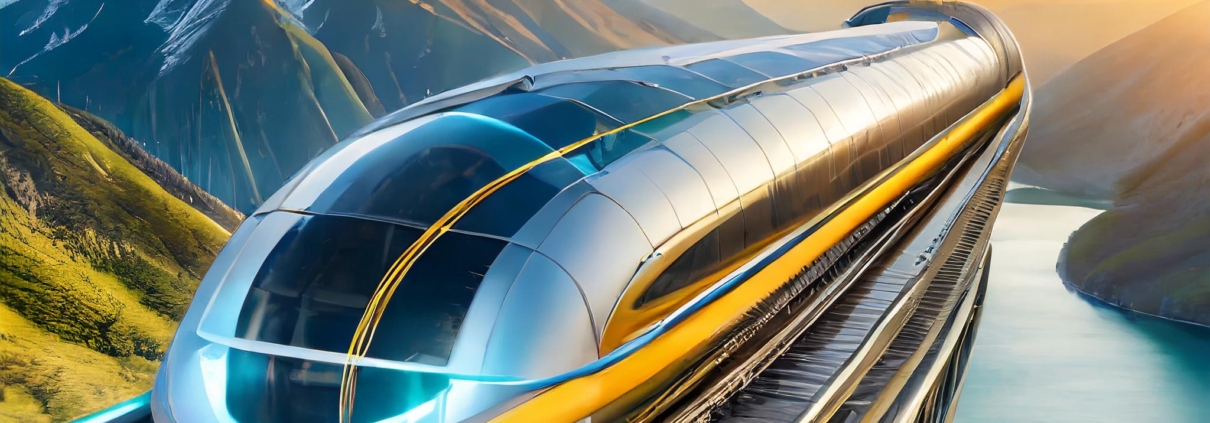Current developments in Hyperloop Technology
Current developments in Hyperloop Technology – What alternative transportation options are available to the public?
The Hyperloop is a proposed mode of transportation that aims to revolutionize travel by using low-pressure tubes to transport passengers or cargo at high speeds. Here is an overview of the Hyperloop Transportation System, its current developments, and some alternative transportation technologies.
Hyperloop Transportation System
1. Concept :
- Elon Musk initially proposed the Hyperloop concept in a white paper published in 2013. It involves pods or capsules travelling through a reduced-pressure tube at speeds exceeding those of traditional modes of transportation.
- The low-pressure environment inside the tube minimizes air resistance, allowing the pods to travel at near-supersonic speeds using magnetic levitation and linear induction motors.
2. Key Features :
- Vacuum Tubes: Hyperloop tubes maintain low pressure to reduce air resistance and friction, enabling high-speed travel.
- Magnetic Levitation (Maglev): Pods are levitated and propelled through magnetic levitation technology, which reduces friction and enables efficient, smooth travel.
- Autonomous Operation: Hyperloop pods are autonomous and guided by sensors, GPS, and advanced control systems.
3. Current Developments in Hyperloop Technology :
- Several companies are actively working on developing Hyperloop Technology, including Virgin Hyperloop, Hyperloop Transportation Technologies (HTT), SpaceX and EPFL in Switzerland.
- Virgin Hyperloop conducted the world’s first passenger test in November 2020, with two passengers travelling inside a Hyperloop pod at the company’s test track in Nevada, USA.
- HTT is working on developing commercial Hyperloop systems in several countries, including the United Arab Emirates, India, and South Korea.
- SpaceX has hosted multiple Hyperloop Pod Competitions, inviting student teams to design and build Hyperloop pods to test them on its test track in California.
- EPFL has built a small pilot vacuum tube circle where tests on reduced size are ongoing.
4. Challenges and Considerations :
- Regulatory Approval: Implementing Hyperloop systems requires regulatory approval and compliance with safety standards, which can vary across jurisdictions.
- Cost and Financing: Developing and deploying Hyperloop infrastructure involves significant capital investment, and financing remains challenging for many projects.
- Technical Feasibility: Scaling up Hyperloop Technology presents technical challenges, such as maintaining low-pressure environments over long distances and ensuring safety and reliability at high speeds.
Alternative Transportation Technologies :
- Maglev Trains: Maglev (magnetic levitation) trains use magnetic forces to levitate and propel train cars, allowing for smooth, high-speed travel with minimal friction. Maglev trains currently operate in countries like Japan, China, and Germany. The technology has shown reliability, and trains have been running for many years.
- High-Speed Rail: High-speed rail systems, such as Japan’s Shinkansen and France’s TGV, offer fast and efficient transportation between cities. These trains travel at speeds of up to 200-300 mph (320-480 km/h) and are often considered a more feasible option than Hyperloop in the short term. The TGV has progressed to a level where it is commonly chosen over air transportation.
- Autonomous Vehicles: Autonomous vehicles (AVs) have the potential to revolutionize transportation by providing on-demand, driverless mobility. Companies like Waymo, Tesla, and Uber are investing in AV technology, although widespread adoption and regulatory approval are still pending.
- Electric Vehicles (EVs): Electric vehicles, including cars, buses, and trucks, offer a cleaner and more sustainable alternative to traditional gasoline and diesel vehicles. The progress made in battery technology and charging infrastructure facilitates the shift towards electric transportation.
- Personal Rapid Transit (PRT): PRT systems use small, automated vehicles to transport passengers on demand within a network of dedicated guideways. Compared to traditional transit options, PRT systems offer flexibility, convenience, and reduced congestion.
- Bicycle and Pedestrian Infrastructure: Investing in bicycle lanes, pedestrian-friendly streets, and micro-mobility options such as scooters and e-bikes promotes sustainable and active transportation modes, reducing reliance on cars and improving urban mobility.
These alternative transportation technologies complement Hyperloop Technology and offer diverse solutions to address the challenges of urban mobility, congestion, and environmental sustainability. Each technology has its own strengths, limitations, and suitability depending on factors such as geography, population density, and infrastructure investment.


